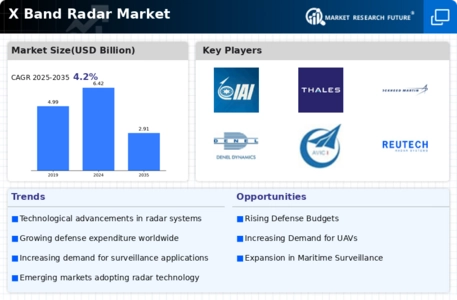Growing Focus on Homeland Security
The X Band Radar Market is significantly influenced by the growing emphasis on homeland security. Governments are prioritizing the development of robust surveillance systems to protect borders and critical infrastructure. This focus has led to increased investments in radar technologies that can provide comprehensive monitoring capabilities. The market is likely to see a rise in demand for X Band radar systems that can operate effectively in various environmental conditions, ensuring reliable performance. As nations enhance their security measures, the X Band radar segment is expected to play a pivotal role in these initiatives.
Increased Demand in Defense Sector
The X Band Radar Market is witnessing heightened demand from the defense sector, primarily due to the need for advanced surveillance and reconnaissance systems. Nations are investing significantly in upgrading their military capabilities, which includes the procurement of sophisticated radar systems. The market is expected to reach a valuation of USD 3.5 billion by 2026, reflecting a robust growth trajectory. This demand is fueled by geopolitical tensions and the necessity for enhanced situational awareness in military operations. Consequently, defense contractors are increasingly focusing on developing X Band radar solutions to meet these evolving requirements.
Expansion into Commercial Applications
The X Band Radar Market is diversifying as it expands into commercial applications beyond traditional military uses. Industries such as aviation, maritime, and automotive are increasingly adopting X Band radar technology for various purposes, including air traffic control, vessel tracking, and collision avoidance systems. This expansion is indicative of a broader trend where radar technology is being leveraged for safety and efficiency in commercial operations. The market for commercial radar applications is projected to grow significantly, potentially reaching USD 1.2 billion by 2027, as more sectors recognize the benefits of X Band radar systems.
Emerging Applications in Weather Monitoring
The X Band Radar Market is also benefiting from emerging applications in weather monitoring and forecasting. The ability of X Band radar systems to provide high-resolution data on precipitation and storm patterns is becoming increasingly valuable for meteorological agencies. This capability allows for more accurate weather predictions and timely warnings, which are essential for disaster management. As climate change continues to impact weather patterns, the demand for advanced radar systems in meteorology is likely to grow. The integration of X Band radar technology into weather monitoring systems could enhance the overall effectiveness of forecasting efforts.
Technological Advancements in Radar Systems
The X Band Radar Market is experiencing a surge in technological advancements that enhance radar capabilities. Innovations such as phased array technology and digital signal processing are improving target detection and tracking accuracy. These advancements are crucial for applications in defense and surveillance, where precision is paramount. The integration of artificial intelligence and machine learning into radar systems is also gaining traction, allowing for real-time data analysis and decision-making. As a result, the market is projected to grow at a compound annual growth rate of approximately 5.2% over the next five years, driven by these technological enhancements.

















Leave a Comment